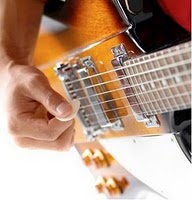One of the most important and useful lead guitar techniques beginner guitarists must learn at an early stage is alternate picking.
Most beginners tend to pick the strings only downwards, which is a bad habit to get used to. If it's not dealt with right in the beginning, changing to alternate picking will be harder later on.

Learning alternate picking will increase playing fluidity and efficiency. The process of picking strings alternately is the process of using a guitar pick to pluck the strings using an alternating pattern of downward and upward plucks, in other words, playing with strictly alternating downward and upward motions.
Why is alternate picking so beneficial?
Because it has a result of minimizing wasted motion, increasing your plucking speed, and ultimately resulting in smoother playing. It allows you to play a series of picked notes fluently and cleanly, and also improves your sense of rhythm.
Many beginners have a hard time learning it at first. As part of our guitar lessons for beginners, here are a couple of useful tips on how to learn alternate picking.
- Grap the plectrum comfortably between your thumb and index finger.
- Make sure only a small part of your pick is protruding from your fingers. If too much of the pick is out, you will most likely get stuck on a string.
- Place your pick at a 45 degree angle with the strings, so the flat part of the pick is not totally parallel with the string. This will help you in not getting the pick caught up on the strings.
- Don't let the tip of your pick move to far from either side of your string you are picking. This also increases speed and versatility.
- Move your wrist to the side, not up and down. This will make the process of picking up-down feel natural to your wrist as well. You can actually practice this sideways motion of the wrist when you are not playing the guitar as well. Just place your hand on a flat surface, imitate how you would hold the pick, and move your wrist in a sideways motion.
- Be patient and keep practicing though as good alternate picking takes practice and discipline.
Many people have difficulty alternate picking different strings. This is easy to get good at with some practice.
When you need to pick a different string in a sequence of notes, make sure you pick it in the opposite direction of your last pick. For example, if you picked the low E string downwards, and need to pick the A string next, you would pick it upwards.
The reverse is true as well, if you just plucked the low E string upwards, you would next pick the A string downwards.
So make sure you keep the alternate picking motion going even if you change to a different string, this will really help in keeping your plucking motion fluent.
Useful Tip
Learning and advancing your alternate picking technique is fun when you play songs that will allow you to practice the technique. Check out our video guitar lesson on Wipe Out, it will give you a great chance to practice the technique in a musical manner.
Remember that learning all-new guitar techniques takes patience and practice, the same goes for alternate picking.
You will soon see that your tone, speed, accuracy, and fluid picking will help you progress and become a great guitarist.
Remember that practicing alternate picking through playing beginner guitar songs is a great way of learning this, and many other techniques as well.


Alternate picking is one really difficult technique for me. I sure want to learn this and I know that these tips you have shared will really help me out. Good thing there are posts like this to assist beginners who are learning on their own. Thank you for your blog.
I would disagree with Chris in regards to learning economy picking “rather the forcefully alternate picking” and helping fluidity. Economy picking is easier than alternate picking,and for beginners, teaches bad habits when alternate picking is needed. Making things easier does not make better guitarists. The best, and really only, way to learn fluidity is to slow your playing down and use a metronome, concentrating on economy of motion and form. Only once alternate picking is learned and can be performed with a fair amount of precision should economy picking be added, because then you can use it a tool versus using it as a crutch for poor alternate picking skill. Good article though.
I was using a thick pick for sixth months and couldn’t get down picking at all. I used a thinner pick and I was capable of picking faster. Make sure you keep the thickness in mind, and as Lee said, the shape matters as well.
The shape of the pick can made a big difference to speed.
thanx man…nice writing…m practising alternate picking …was difficult at first but is getting easier with practise…
Alternate guitar picking is a must to learn if you want to become a proficient guitarist. Picking plays a huge part in speed and fluent playing. Some great tips here, thanks!
A great guide for beginners. It might be worth creating an article on economy picking if you haven’t done so already. It’s kind of relevant to this and a fairly useful skill to have rather than forcefully alternate picking. It helps fluidity.